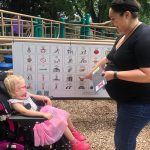
Thanksgiving is a time for gathering, gratitude, and delicious food. For families with a child with special needs, celebrating Thanksgiving may require some thoughtful preparation to ensure a comfortable and enjoyable experience. With the right approach, you can help your child feel more at ease, engaged, and included in the festivities. Here are some tips to help you prepare for a meaningful holiday celebration.
Prepare in Advance
The more predictable the day, the more comfortable your child will feel. Start by telling your child about Thanksgiving well in advance. You might use visual aids, like a calendar or countdown, to show when Thanksgiving is coming up. Social stories, which explain what Thanksgiving is, who will be there, and what typically happens, can also be helpful. Providing this information ahead of time can reduce anxiety and give your child a sense of control over what to expect.
Create a Visual Schedule
A visual schedule is an excellent tool for outlining the day’s events in a clear, predictable way. You could create simple cards or pictures representing each activity—like “arriving at grandma’s house,” “dinner time,” and “quiet time.” A schedule helps the child understand the sequence of activities and reduces the unknown, which can make the day less overwhelming.
Set Up a Sensory-Friendly Environment
Thanksgiving gatherings are often filled with sensory stimuli that can be overwhelming for children with sensory sensitivities. Consider the lighting, sounds, and even textures in the environment. If your child is sensitive to certain smells, sounds, or textures, be prepared to make adjustments. For example, create a quiet room or cozy nook where they can go to decompress if needed, or consider using dim lighting and keeping noise levels low in shared spaces.
Include Familiar Foods
Traditional Thanksgiving foods are delicious, but they may not appeal to every child. Be sure to include some of your child’s favorite, familiar foods in the meal, even if they’re not typically part of Thanksgiving. Having these favorite items on their plate can make the meal feel more comfortable and enjoyable.
Use Social Stories
Social stories are an invaluable tool to help children understand what will happen at Thanksgiving. You can create a social story that explains who will be there, what activities will take place, and any special traditions that will be observed. For example, if there will be a toast or a special prayer, include that in the story to help prepare them. Reading the story together in the days leading up to Thanksgiving can help reduce anxiety and provide a comforting sense of predictability.
Prepare Your Guests
If you’re hosting guests, take a moment to tell them about your child’s preferences and sensory sensitivities. Let them know ways they can interact positively with your child and how to respect their boundaries. For instance, if your child prefers not to be hugged, kindly share this with family members so everyone can create a supportive and respectful environment.
Plan for Breaks
Holiday gatherings can be overwhelming, and recognizing when your child may need a break can make a big difference. Have a designated quiet space where your child can go if they need time to recharge. Whether it’s a room with comfortable seating or a cozy corner, this can be a lifesaver when the day starts to feel overstimulating.
Incorporate Special Interests
If your child has a particular interest, try to weave it into the Thanksgiving celebration. Whether it’s animals, trains, or a favorite character, incorporating their interests can help them feel more engaged and make the holiday more enjoyable. For example, if they love animals, you could include animal-themed decorations or read a story about animals during a quiet moment.
Engage in Preferred Activities
Activities that your child enjoys can be grounding and comforting, especially in a social setting. Plan some activities they’re familiar with, such as a favorite board game, craft, or outdoor activity. Not only will this give them something to look forward to, but it can also create opportunities for positive interactions with family members.
Communicate Clearly
Using clear and direct language can go a long way in helping your child feel confident. Explain the day’s schedule, the expectations, and any changes to the plan. Keeping your communication straightforward and consistent can ease uncertainty and make them feel more secure. If you’re not sure how to simplify communication, consider asking your child’s speech therapist for ideas on how to frame plans and expectations in a clear, child-friendly way.
Respect Sensory Needs and Personal Space
Be mindful of your child’s sensory needs and personal boundaries. If they prefer not to be touched or hugged, let others know in advance. Respecting their need for space and familiar sensory experiences can help them feel more comfortable, less anxious, and ready to enjoy the holiday in their own way.
Celebrate in Smaller Groups
If possible, consider celebrating Thanksgiving in a smaller, more intimate setting to reduce the level of excitement. A quieter environment with fewer people may be less overwhelming and easier for your child to navigate. This can make it easier for them to relax and enjoy the holiday, creating a setting where they feel safe and supported.
Final Thoughts
Every child with special needs is unique, and what works for one may not work for another. Use the suggestions that best fit your child’s preferences, personality, and sensory needs to make the holiday as enjoyable as possible. Communicate with your child and other caregivers about what to expect, and remember that flexibility and patience can make all the difference.
Thanksgiving is about giving thanks, and by creating a warm, understanding environment, you can help your child feel included in the celebration. With a bit of preparation, you can create a Thanksgiving experience that everyone will remember with gratitude









